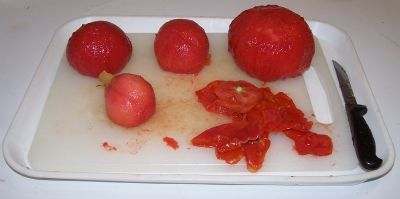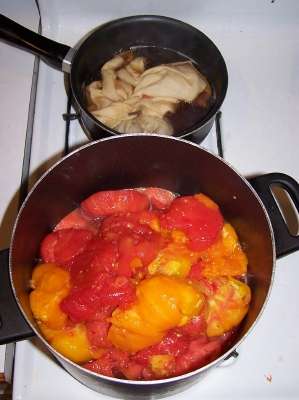
Looking for How to Make Homemade Barbecue Sauce / BBQ Sauce - Easily! in 2025? Scroll down this page and follow the links. And if you bring home some fruit or vegetables and want to can, freeze, make jam, salsa or pickles, see this page for simple, reliable, illustrated canning, freezing or preserving directions. There are plenty of other related resources, click on the resources dropdown above. If you are having a hard time finding canning lids, I've used these, and they're a great price & ship in 2 days.
If you have questions or feedback, please let me know! There are affiliate links on this page. Read our disclosure policy to learn more.
How to Make Homemade Barbecue Sauce / BBQ Sauce - Easily!
Making and Canning Homemade Barbecue Sauce from Fresh Tomatoes!
Click here for a PDF print version
Barbecue sauce is a treasured condiment to many folks. There are many types of bbq sauces, from the vinegar-based North Carolina sauce to the sweet, tomato-based Memphis sauces, and mustard-based sauces of south Georgia.. and many others. Perhaps you even have you own secret family recipe for making barbecue sauce?
And if you have a mountain of homegrown tomatoes that are going to waste, here's your chance to make your own barbecue sauce and customize to your own taste, can and use all year or give away as presents!
- Need a low-salt diet? Skip the salt!
- Prefer a honey BBQ sauce? Substitute honey for brown sugar!
- Want a spicy barbecue sauce? Add some Tabasco or chilies.
- Need a sugar-free BBQ sauce? Substitute Stevia (in a prepared form like Truvia, it measures same as sugar; if you use another form, you will need do your own conversion) - or Splenda, if you prefer, for brown sugar!
Making and canning your own barbecue sauce is something families remember years later. No store bought barbecue sauce compares with the taste of that made from your own tomatoes from your garden or fresh-picked from a local farm! In the middle of the winter, you can pour the barbecue sauce on your food and taste the summer flavor of fresh tomatoes.
Here's how to do it, in easy steps and completely illustrated. This method is easy, and by using a crockpot to cook the tomatoes down, you can make it with much less effort! It's a great thing to do with your kids!
You may also be interested in making your own catsup! Or interested in How to make cucumber pickle relish! This is the classic hamburger relish!
Ingredients and Equipment
Yield: About 4 pint jars or 8 oz jars
|
|
Process - How to Make Barbecue Sauce from Fresh Tomatoes
Step 1 - Selecting the tomatoes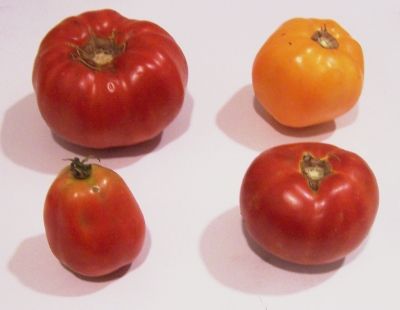
It's fun to go pick your own and you can obviously get better quality tomatoes! If you are starting with canned tomatoes or tomato sauce, skip to step 7.
At right is a picture of tomatoes from my garden - they are so much better than anything from the grocery store. And if you don't have enough, a pick-your-own farm is the pace to go! Below are 4 common varieties that will work:
| Top left: Beefsteak | Top right: Lemon Boy, yellow |
| Bottom left: Roma, paste-type | Bottom right: Better Boy |
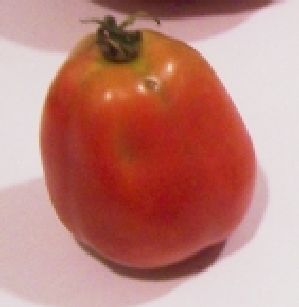 The
picture at left shows the best variety of tomato to use: Roma; also called
paste tomatoes. they have fewer sides, thicker, meatier walls, and
less water.
The
picture at left shows the best variety of tomato to use: Roma; also called
paste tomatoes. they have fewer sides, thicker, meatier walls, and
less water.
Also, you don't want mushy, bruised or rotten tomatoes!
Step 2 - Get the jars and lids sanitizing
 The
dishwasher is fine for the jars; especially if it has a "sanitize" cycle.
I get that going about 30 minutes before I figure the barbecue sauce has
cooked down enough (yes, that's a bit vague!)
The
dishwasher is fine for the jars; especially if it has a "sanitize" cycle.
I get that going about 30 minutes before I figure the barbecue sauce has
cooked down enough (yes, that's a bit vague!)
Be sure to let it go through the rinse cycle to get rid of any soap! It's also a good time to start heating up the water in the canner and the small pan of water to warm the lids to soften the adhesive.
Lids: Put the very hot (but not quite boiling; around 180 F,
steaming water is fine)
water for at least several minutes.
Note: everything gets sanitized in the water bath (step 12), so this just helps to ensure there is no spoilage later!)
Step 3 - Removing the tomato skins (Optional)
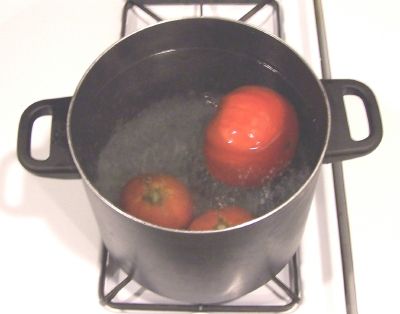 I
generally remove the skins first if the skins are nasty looking OR if I
have any doubt as to whether pesticides were used because they are usually
concentrated in the skins. Otherwise, you can skip to step 3.
I
generally remove the skins first if the skins are nasty looking OR if I
have any doubt as to whether pesticides were used because they are usually
concentrated in the skins. Otherwise, you can skip to step 3.
Here's a trick you may not know: put the tomatoes, a few at a time in a large pot of boiling water for no more than 1 minute (30 - 45 seconds is usually enough)
then....
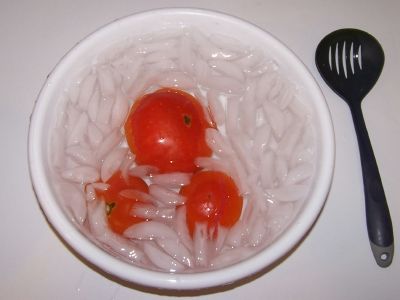 Plunge
them into a waiting bowl of ice water.
Plunge
them into a waiting bowl of ice water.
This makes the skins slide right off of the tomatoes!
Step 4 - Removing most of the seeds and water
After you have peeled the skins off the tomatoes (or not, if you decided to leave the skins on), cut the tomatoes in half and cut out the woody part neat the stem, and any bruised areas. Now we need to remove the seeds and excess water. Why do this? Getting rid of excess water will reduce cooking time later. And it eliminates the need to strain the sauce.
Step 5 - Squeeze of the seeds and water
 Just
like it sounds: wash your hands then squeeze each tomato and use your
finger or a spoon to scoop and shake out most of the seeds. You
don't need to get fanatical about it; removing just most
Just
like it sounds: wash your hands then squeeze each tomato and use your
finger or a spoon to scoop and shake out most of the seeds. You
don't need to get fanatical about it; removing just most
 will
do.
will
do.
Step 6 - Drain the tomatoes
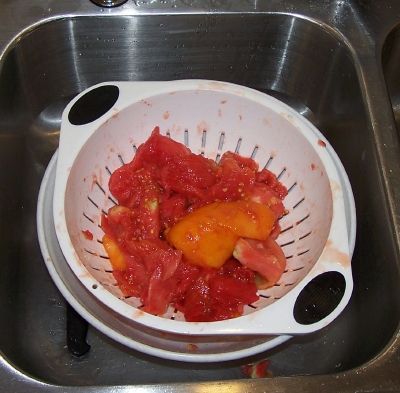 Toss
the squeezed (Squozen? :) tomatoes into a colander or drainer, while you
work on others. This helps more of the water to drain off. You may
want to save the liquid: if you then pass it through a sieve, screen or
cheesecloth, you have fresh tomato juice; great to drink cold or use in
cooking!
Toss
the squeezed (Squozen? :) tomatoes into a colander or drainer, while you
work on others. This helps more of the water to drain off. You may
want to save the liquid: if you then pass it through a sieve, screen or
cheesecloth, you have fresh tomato juice; great to drink cold or use in
cooking!
Step 7 - Prepare the seasonings
Prepare the following and dump them 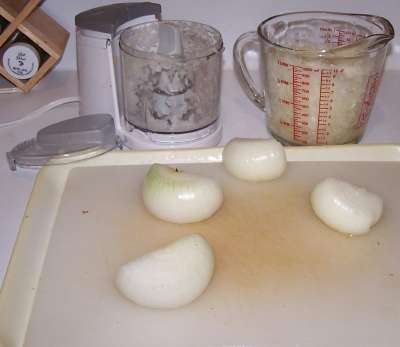 all
together in a bowl:
all
together in a bowl:
- 2 cups chopped celery
- 2 cups chopped onions
- 11/2 cups chopped sweet red or green peppers (about 3 medium peppers)
- 2 hot red peppers, cored, and chopped
- 2 cloves garlic, crushed or minced
Variations: as long as you keep the proportions consistent with the above, you can do some substitution, if your family recipe calls for garlic, or other similar vegetables.
Step 8 - Start the tomatoes simmering in a large pot
Put the tomatoes in a large pot to start simmering.
Step 9. Add the Seasonings
Into the pot of simmering tomatoes, add:
- The seasonings from step 6
- 1 teaspoon black pepper, ground
- 1 cup brown sugar (or honey, if you prefer - or Stevia (in a prepared form like Truvia, it measures same as sugar; if you use another form, you will need do your own conversion) - or Splenda, if you prefer, if you are diabetic)
- 1 tablespoon dry mustard
- 1 tablespoon paprika
- 1 tablespoon canning salt (optional - I don't put any in!)
- 1 teaspoon hot pepper sauce (like, TabascoⓇ)
- 1/8 teaspoon cayenne pepper
- 11/2 cups of (5%) vinegar (white apple or red wine vinegar)
Increase the black pepper, cayenne pepper, paprika and / or hot sauce if you want a hotter barbecue sauce. And again, if your family recipe calls for other herbs or spices, go ahead and substitute. As long as it doesn't substantially change the overall total quantity of herbs or spices, it shouldn't affect the safety of the canning process.
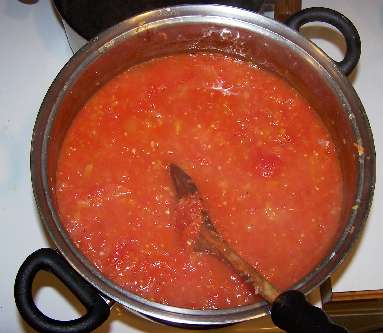 Step
10 - Bring the tomatoes to a gentle simmer for 30 minutes
Step
10 - Bring the tomatoes to a gentle simmer for 30 minutes
Cook until vegetables are soft (about 30 minutes). This helps to separate
the seeds and skins, and soften the vegetables to be sieved or pureed.Step 11 - Removing the seeds and skins
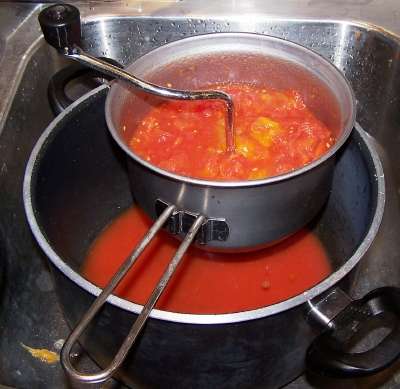 Run
the cooked tomato mixture through the food mill or sieve OR puree it all
together in a blender or food processor. Discard any seeds and skins that
remain in the sieve..
Run
the cooked tomato mixture through the food mill or sieve OR puree it all
together in a blender or food processor. Discard any seeds and skins that
remain in the sieve..
The food mill has the advantage of removing skins and seeds if you didn't do so earlier (in step 2), but if you use the blender or food processor, you will get slightly more per batch.
Step 12 - Cook down to thicken the mix
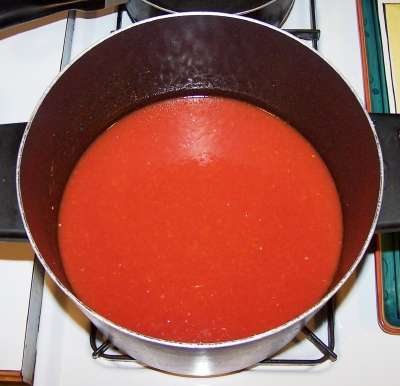
Cook the mixture until it is reduced to the thickness that you like! On average, that would be about one half the volume, which would take about 2 or 3 hours on cooking and stirring on the stove over medium-low heat.
You can do it on the stove over low - medium heat, stirring frequently, as shown at right.. OR....
.. put it into a crockpot and let it cook down by itself. this method
is
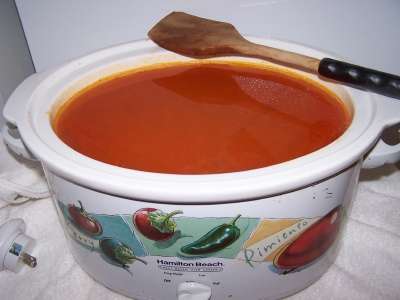 much
easier! I find it takes about 3 hours, but each crockpot may vary.
You want it to get as thick as you like your barbecue sauce, remembering that it
will also thicken a little bit after you cool it. The photo doesn't show
it, but I cover with a splatter screen or the lid on loosely (so the steam can
escape). You need only come by and stir once every 30 minutes or so.
much
easier! I find it takes about 3 hours, but each crockpot may vary.
You want it to get as thick as you like your barbecue sauce, remembering that it
will also thicken a little bit after you cool it. The photo doesn't show
it, but I cover with a splatter screen or the lid on loosely (so the steam can
escape). You need only come by and stir once every 30 minutes or so.
Step 13 - Fill the jars with the barbecue sauce and put the lid and
rings on
on
Fill them to within 1/4-inch of the top, seat the lid and hand-tighten the ring around them.
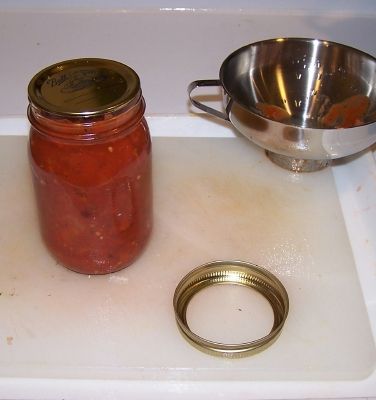 Be
sure the contact surfaces (top of the jar and underside of the ring) are
clean to get a good seal!
Be
sure the contact surfaces (top of the jar and underside of the ring) are
clean to get a good seal!
Step 14 - Process (boil) the jars in the canner
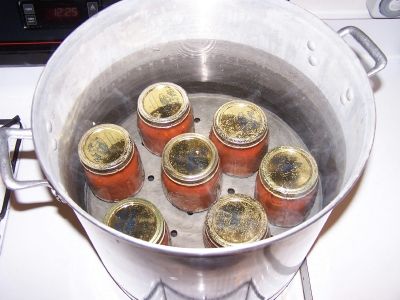 Put
them in the canner and keep them covered with at least 1 inch of water.
Keep the water boiling. Process the jars in a boiling-water bath for 35
minutes for pints and 40 minutes for quarts. Remember to adjust the time
if you are at a different altitude other than sea level!
Put
them in the canner and keep them covered with at least 1 inch of water.
Keep the water boiling. Process the jars in a boiling-water bath for 35
minutes for pints and 40 minutes for quarts. Remember to adjust the time
if you are at a different altitude other than sea level!
|
Recommended process time for Barbecue Sauce in a boiling water canner. |
||||
| Hot Pack Method | Process Time at Altitudes of | |||
| Jar Size | 0 - 1,000 ft | 1,001 - 3,000 ft | 3,001 - 6,000 ft | Above 6,000 ft |
| Half-pints or Pints | 20 min | 25 min | 30 min | 35 min |
If you have a Pressure Canner, be sure to follow their directions.
 If
you have a Pressure Canner, use it and process the sauce for 20 minutes for pint
jars and 25 minutes for quarts, at a pressure of 10 to 11 pounds. I prefer a
pressure canner or a larger 33 quarter water bath canner, shown above - both are
much deeper, so there is no mess, no boilovers, and allows you to cover the
tallest jars with several inches of water to ensure safety! To order one, click
on
Canning supplies and select
the canner that is right for your stove (regular or flat bottomed for glass or
ceramic stoves)
If
you have a Pressure Canner, use it and process the sauce for 20 minutes for pint
jars and 25 minutes for quarts, at a pressure of 10 to 11 pounds. I prefer a
pressure canner or a larger 33 quarter water bath canner, shown above - both are
much deeper, so there is no mess, no boilovers, and allows you to cover the
tallest jars with several inches of water to ensure safety! To order one, click
on
Canning supplies and select
the canner that is right for your stove (regular or flat bottomed for glass or
ceramic stoves)
Step 15 - Done
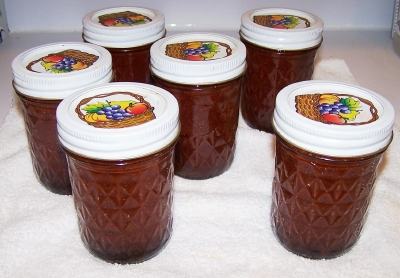 Lift
the jars out of the water and let them cool without touching or bumping
them in a draft-free place (usually takes overnight) You can then
remove the rings if you like, but if you leave them on, at least loosen
them quite a bit, so they don't rust in place due to trapped moisture.
Once the jars are cool, you can check that they are sealed verifying that
the lid has been sucked down. Just press in the center, gently, with your
finger. If it pops up and down (often making a popping sound), it is not
sealed. If you put the jar in the refrigerator right away, you can still
use it. Some people replace the lid and reprocess the jar, then that's a
bit iffy. If you heat the contents back up, re-jar them (with a new lid)
and the full time in the canner, it's usually ok.
Lift
the jars out of the water and let them cool without touching or bumping
them in a draft-free place (usually takes overnight) You can then
remove the rings if you like, but if you leave them on, at least loosen
them quite a bit, so they don't rust in place due to trapped moisture.
Once the jars are cool, you can check that they are sealed verifying that
the lid has been sucked down. Just press in the center, gently, with your
finger. If it pops up and down (often making a popping sound), it is not
sealed. If you put the jar in the refrigerator right away, you can still
use it. Some people replace the lid and reprocess the jar, then that's a
bit iffy. If you heat the contents back up, re-jar them (with a new lid)
and the full time in the canner, it's usually ok.
Other Equipment:
 From
left to right:
From
left to right:
- Jar lifting tongs
to pick up hot jars - Lid lifter
- to remove lids from the pot
of boiling water (sterilizing ) - Lids
- disposable - you may only
use them once - Ring
- holds the lids on the jar until after
the jars cool - then you remove them, save them and reuse them - Canning Jar funnel
- to fill the jars
Summary - Cost of Making Homemade Barbecue Sauce - makes 7 - 8 oz jars* |
||||
| Item | Quantity | Cost in 2025 | Source | Subtotal |
| Tomatoes | 25 lbs (to make about 16 cups of prepared tomato) | "free" from the garden, or $0.50 cents/lb at a PYO | Garden | $0.00 |
| Canning jars (8 oz size, wide mouth), includes lids and rings | 7 jars | $7.00/dozen | Grocery stores, like Publix, Kroger and Safeway and local "big box" stores; sometimes Big Lots and even hardware stores | $4.50 |
| seasoning | See step 7 | $1.00? assuming you already have them. just the fraction you will use. | Grocery stores, like Publix, Kroger and Safeway and local "big box" stores | $1.00 |
| Celery, onions, pepper | about 2 cups each | $3.00 | Grocery stores, like Publix, Kroger and Safeway and local "big box" stores | $3.00 |
| Total | $8.50 total or about $2.13 per pint jar INCLUDING the jars - which you can reuse! |
|||
|
* - This assumes you already have the pots, pans, ladles,, and reusable equipment. Note that you can reuse the jars! |
||||
Looking for canning equipment and supplies?
Water bath canner with a jar rack
Pressure canners for gas, electric and induction stoves: Presto 23Qt or T-fal 22Qt
Canning scoop (this one is PERFECT)
Ball Blue book (most recent version)
Jars: 8oz canning jars for jams
Find Other types of farms:
Farm markets and roadside stands
Road trips and camping resources
Local Honey, apiaries, beekeepers
Consumer fraud and scams information
Home canning supplies at the best prices on the internet!
Maple Syrup Farms, sugarworks, maple syrup festivals
Environmental information and resources
Farms For Your Event for birthday parties, weddings, receptions, business meetings, retreats, etc.
Festivals - local fruit and vegetable festivals
Get the
most recent version of
the Ball Blue Book
With this Presto 23 quart pressure canner and pressure cooker, you can "can" everything, fruits, vegetables, jams, jellies, salsa, applesauce, pickles, even meats, soups, stews. Model 01781

You can make jams, jellies, can fruit, applesauce, salsa and pickles with water bath canners, like this Granite Ware 12-Piece Canner Kit, Jar Rack, Blancher, Colander and 5 piece Canning Tool Set

